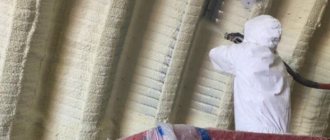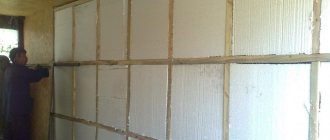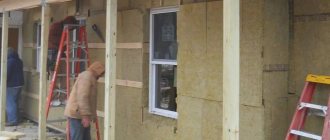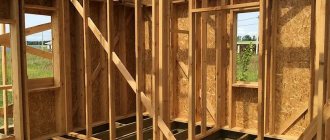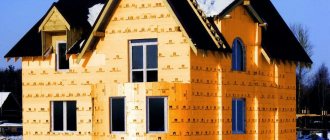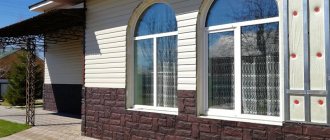The construction of houses using frame-panel technology is becoming increasingly popular. This trend is due to the availability on the market of new modern materials, in particular effective insulation materials such as polyurethane foam. What characteristics does this material have, how can it be used to insulate a house, how to calculate the required consumption per area and the cost of insulating the PPU, we will consider further.
Scope of application
Polyurethane foam is applied to surfaces only by spraying. Liquid insulation is easy to apply and dries instantly. Its peculiarity is that it is evenly distributed along a given path and does not leave gaps or joints after complete hardening. With it, all operations are performed many times faster than with any other insulating substance.
The material is applied to any surface, be it wood, iron, concrete, metal structures or mixed types of walls and ceilings. Polyurethane foam is applied to residential buildings, houses, structures, industrial warehouses, collectors, and is used in large-scale applications. This is an ideal insulation for any structures and elements.
Since ancient times, people have paid sufficient attention to insulating their baths.
After all, the quality of insulation of a bathhouse or sauna structure is directly related to the quality of the parka.
For quite a long time, mineral wool was used to insulate baths, which lost its importance and lost its competitiveness with the advent of polyurethane foam on the building materials market.
As you know, this material works on the principle of a thermos, retaining heat inside. This principle is achieved by spraying the building material, which eliminates any gaps and air penetration.
Also, it should be noted that a rather important fact is that polyurethane foam has a G2 fire certificate. This guarantees the preservation of the premises even with a high risk of fire.
The main feature that is characteristic only of polyurethane foam is the environmentally friendly materials that are used to create the insulation. And since a bathhouse or sauna requires a high percentage of humidity, as well as high temperature, this quality is extremely necessary.
The difference between polyurethane and polystyrene
Polyurethane foam has a close analogue - polystyrene. These insulation materials are similar in technical characteristics to each other. But the latter belongs to the group of slab insulation materials produced by foaming. It has a lot of advantages compared to other slab heat-insulating compositions, but the functionality is a little limited when compared with polyurethane foam.
Expanded polystyrene is not used for spraying pipes, ventilation ducts and other elements with complex geometry. But it is possible to apply the material yourself, without using additional equipment. PPU foam is supplied exclusively from a specialized unit. There are exceptions, but such options cannot be used for large areas.
Preparing for self-application
Polyurethane foam is considered one of the most difficult thermal insulation materials to install. It is much easier for the owner of the house to call specialists who know the installation technology and have the necessary equipment.
But independent installation is also possible, although it requires thorough preparation.
Kit for self-insulation
To insulate walls with your own hands you will need:
- 2 cylinders with polyol and isocyanate.
- Spray gun.
- A compressor that creates the pressure necessary to atomize the material.
- Heads (nozzles) on the gun that allow you to regulate the volume of foam flow and its pressure.
- Personal protective equipment: respirator, gloves, suit.
- Heating block (optional; required for operation at low temperatures);
CAREFULLY!
Working without protective equipment is strictly not recommended. Polyurethane foam loses its toxic properties only after complete hardening; until this point, inhaling its vapors can be harmful to health.
Insulation of a frame house with polyurethane foam
A frame house must be insulated with high-quality materials. In this case, you cannot insulate, for example, only the walls, and forget to insulate the ceiling. The entire area of the room must be hermetically sealed with a good composition so that cold currents cannot penetrate inside and heat does not escape beyond its boundaries. When calculating polyurethane foam insulation, all components of a frame house are taken into account. These are walls, ceilings, attic coverings, joints, and gaps.
Pie wall
The rule for insulating enclosing structures says: the value of vapor permeability should increase from the inside to the outside. When processing walls made of brick, foam and gas blocks, this principle is observed. Applying polyurethane foam to houses built from timber, logs or carriages can lead to the destruction of wooden structures, because a layer of thermal insulation traps moisture inside the wall. To eliminate the negative consequences of insulation, you need to install a vapor barrier from the inside with overlapping and gluing the joints and organize supply and exhaust ventilation.
Thermal insulation of one-story and multi-story buildings
Polyurethane foam is a universal insulation material that can be used to insulate absolutely all structures, be they frame, brick, panel, block or wood. It is only important to take into account the severity of the loads on mechanical structures. An insulating substance is applied to the internal and external facades of the walls.
It is necessary to understand that for wooden, brick and concrete walls it is necessary to create an additional frame for the cladding. It is on this that the façade panel and other similar facing material are then attached.
If there are inclined elements, there is no need to worry about the adhesion of the material to them. Polyurethane foam hardens well on them, and does not spread to the side.
Today, most garage owners are thinking about insulating them.
And quite often these people ask questions about what materials should be used to improve their garage and storage area for their vehicle.
In order to clearly understand what materials are suitable for finishing this kind of room, you need to understand what a garage is and its design. First of all, you should understand that a garage is a type of premises that not only differs in its purpose, but also has the property of being flammable. Therefore, we understand that a heat insulator must exclude any means of combustion. That is why the use of polyurethane foam is the safest and most effective. Because it is precisely due to the application of the material by spraying that the applied material does not ignite and, in principle, does not belong to flammable materials.
Also, one of the most important aspects that must be taken into account when choosing a material for insulating a garage is that this room is not heated, unlike apartments or other residential premises. In this case, we understand that the selected material must have a sufficiently high-quality composition, thanks to which constant heat will be maintained in the room. Thus, polyurethane foam will be an excellent choice, because it has the highest thermal insulation properties, unlike a number of other building materials used for room insulation.
Thermal insulation of industrial and technical objects
It is very convenient to fill buildings and structures with volumetric dimensions and shapes with polyurethane foam. The spraying method for volumetric quadrature is the most suitable, since it does not require additional work on fastening and installation. This material is often used to cover the interior walls of refrigeration industrial premises. Most often, they always need to be kept at a high temperature. Polyurethane foam can be used for objects that are exposed to temperatures up to 130 degrees.
There are no restrictions on the use of polyurethane foam, so it is actively sprayed onto log floors. But at the same time, the condition of finding a heat-insulating layer between the beams is met. This is important because there should be no compressive loads. Polyurethane foam can withstand sudden temperature changes, so it is applied to all types of pipes, ventilation shafts and elements of production lines.
Calculation of the thickness of the polyurethane foam layer
Heat transfer resistance is a standardized characteristic that is set separately for each region.
The thickness of the polyurethane foam layer must be calculated in accordance with this parameter.
The standards indicate the values of the total heat transfer resistance related to the entire wall structure.
For this reason, the calculations take into account not only insulation materials, but also the parameters of the insulated structure.
Self-calculation formulas are complex and cumbersome, but there are a large number of online calculators that find the required insulation thickness based on user-entered data (region, wall material, its thickness, insulation materials and additional finishing).
The average thickness of the polyurethane foam layer is 10-30 centimeters.
Thermal insulation of frame houses
For frame houses, it is important to use high-quality insulation, which will be able to protect the room from temperature changes and excess moisture. PPU copes with these tasks, and can also well reduce the level of noise penetration, which is also important to consider when using it.
In frame foundations, it is important to insulate every joint, including verandas, attics, and balconies.
Insulation of a frame house: how important is an integrated approach to the matter?
The insulation does not form gaps, adheres tightly to the base, therefore it is used in both horizontal and vertical positions. It is applied to the ceiling, insulating the floor and walls. At the same time, the application technology is followed using special equipment. It is best to entrust this process to professionals who clearly know how much to mix the mixture and how to properly apply it to the surface.
How to insulate a floor in a frame house: technology features
The following conditions are met:
- for the subfloor you need to choose good boards that need to be pressed tightly together;
- to ventilate the underground, you need to use a wind barrier, onto which OSB is additionally screwed on top;
- insulation is laid between the joists;
- a vapor barrier is applied on top of the insulation, which is pulled to the joists with a stapler;
- Finishing plank flooring is made using tongue-and-groove boards.
Insulating the walls of a frame house: materials and technologies
The components that make up polyurethane foam are quite toxic, so they should be supplied only with respirators. After hardening, this material is absolutely harmless and has high thermal insulation properties. The technology of mixing the components occurs in a gun under pressure. The components are heated to 45 degrees. In the form of fine dust under pressure, they are mixed and sprayed onto the surface.
On the surface the composition foams and then hardens. This is the essence of PPU insulation. For work, a material with a closed cellular structure and closed is used. All components must be in the equipment in equal proportions. Exceeding one of them leads to a decrease in the quality of insulation.
Video description
Polyurethane foam filling system, how it works in the “wall”.
Bricks with voids are also suitable for well masonry Source all-for-remont.ru
Such masonry is by no means a relic of the past, but a well-thought-out engineering solution that is still used to this day. First of all, it is a lightweight design, which requires much less building materials, and is also very convenient for creating thermal insulation for a building. The distance between two parallel walls is usually 125-130 mm, that is, half the length of one brick laid across the masonry.
Today, during the construction of buildings, it is impossible to fill such voids with slag - this is due to the fact that the consumption of solid fuel has sharply decreased - most boiler houses have switched to natural gas. Therefore, filling interwall voids with polyurethane foam in modern construction is most welcome. In addition, slag and ground beetles settle over time, turning into dust and their thermal insulation effect deteriorates. In such situations, there is also the possibility of pouring polyurethane foam, but first things first.
Equipment for pouring polyurethane foam
Equipment for filling polyurethane foam Source sprayer.com.ua
As you probably guessed, filling voids with polyurethane foam is done using industrial equipment - there is enough of it on sale, but it is usually bought by those who deal with insulation at a professional level. Let's look at these setups using the Reactor IPH as an example, although you may prefer any other model based on brand or power.
The Reactor IPH unit is used for foaming polyurethane and then pouring it into any voids. At the same time, the machine provides an accurate dosage of polyurethane foam and its supply at different speeds at the operator’s request. For a more precise understanding of the capabilities of models with this name, pay attention to the table below.
| Device brand | Reactor | |
| Modification | IPH-25 | IPH-40 |
| Pressure, Bar | 140 | 140 |
| Productivity maxi, kg/min | 9,5 | 9,2 |
| Heating power, kW | 9,0 | 15,3 |
| Heating of hoses | Yes | Yes |
Without such a kit, starting pouring is strictly prohibited Source vzsto.ru
When pouring polyurethane foam into voids, it is imperative to use a chemical protection suit - those who served in the army are familiar with such clothing. This kit includes:
- overalls with a hood for protection from dust, aerosols, chemicals, acid compounds and alkalis;
- panoramic mask (transparent plastic) with an anti-aerosol respirator;
- cap;
- shoe covers;
- gloves;
- mounting safety belt for working at height.
How to insulate a ceiling in a frame house
Observe the following points:
- Mineral wool is laid on the suspended ceiling;
- use reflective thermal insulation, which is simply glued to the top of the ceiling;
- It is important that the attic space is well isolated from the rest.
You can use one of the insulation methods: make a lath on which you pour foam or build a temporary frame that will consist of two parallel planes. Hoses are pulled to the surface through which foam is supplied.
Be sure to wear a protective suit. Apply the composition from bottom to top in small portions. As the foam expands, make sure that the layer thickness is no less than the required one. After the foam hardens, the excess can be cut off, but the deficiency cannot be made up for.
Application Features
The easiest way is to apply polyurethane foam to the frame cells. When working, the following points are observed:
- the surface is cleaned of dirt and dust and dried;
- work is carried out in calm weather without precipitation;
- the surface should not be heated above 10 degrees;
- the spraying composition should be in the temperature range from 18 to 25 degrees.
Sequence of work
Polyurethane foam is applied alternately into the cells of the frame in several layers. First, hard-to-reach areas are taken, such as corners, pipes, and connection elements. Spraying is carried out evenly without gaps or breaks. It is taken into account that the material tends to expand when applied.
Calculation of the thickness of PPU insulation for a frame house
Open cell material has a high level of noise reduction, so it is used for industrial premises. But according to technical characteristics, the closed type of material is considered to be of higher quality. The thickness of the PPU insulation depends on the climate of the area where the house is being built using frame technology.
The formula for calculating the thickness of thermal insulation material is as follows: the thermal conductivity of the insulation is multiplied with the thermal resistance of the wall. There are special tables for regions that provide additional indicators for calculation. all necessary parameters are indicated on the packaging.
The use of polyurethane foam is not only aimed at one area
Polyurethane foam is designed for insulation of all types of roofs.
Each of us wants our home to be as comfortable as possible at any time of the year. In our time, a similar effect can be achieved in any number of different ways, from the use of high-quality building materials in the initial stages of construction, to the installation of air conditioning systems and additional heating. Thus, in order to create the most comfortable living conditions in wooden houses, it is necessary to use high-quality insulation of walls, as well as other structures through which air can penetrate.
Insulation from the inside with mineral wool. Currently, mineral wool is the main material for insulating houses, which are often used not only in private, but also in multi-story construction. However, such a fairly wide range of uses has many nuances. Thus, mineral wool has a significant disadvantage in the form of minimal wear resistance of the material. Thus, outdated material will allow not only unwanted air into the living space, but also harmful microparticles, as well as unwanted moisture in the gaps.
Insulation with sprayed thermal insulation. Polyurethane foam is recognized as the most effective material for insulating wooden structures. In our country, this method of using polyurethane foam on surfaces is not as relevant as in neighboring countries. For example, in the West, this use has been used for more than 50 years and remains the most successful. Thanks to polyurethane foam, the owner of such a house can save about 50% of the cost of heating and cooling the room.
Prices and terms for insulating a frame house with polyurethane foam
The approximate price tag is as follows. For spraying 80 mm thick, using rigid polyurethane foam, it will cost 1,650 rubles per 100 square meters. A thickness of 200 mm will cost about 3,200 rubles with the same indicators.
Polyurethane foam with a closed-cell structure can be applied in thicknesses of 50, 80 and 100 mm. With a thickness of 50 mm, the price will be 1100 rubles per 100 square meters, 80 mm - 1700 rubles and 100 mm - 2200 rubles.
The timing depends on the area of the premises and the stated requirements. As a rule, specialists fill frame houses in one day. If we are talking about large enterprises, then the work can last for weeks. It is important to consider that over large areas it is possible to apply repeated layers.
Insulating a frame house with polyurethane foam is beneficial not only from the point of view of the durability of the material, but also in other respects. This is an excellent insulating material that will protect your home from the cold, prevent moisture from entering and even reduce the level of noise coming from outside.
General information
Today, a potential buyer has a fairly large assortment of materials to choose from, which differs both in pricing policy and quality of the material, and in the principles of working with it.
- Thus, the technology of home insulation using polyurethane foam is recognized as the most relevant technology.
- Polyurethane foam is considered not only one of the most environmentally friendly, but also very effective materials that can be used for both thermal insulation and sound insulation.
The use of polyurethane foam is recognized as the least expensive and complicated method for insulating a particular object. Such thermal insulation is considered not only high-quality, but also a unique application technology, which eliminates all possible ways of cold penetration into the premises. Also, it should be noted that polyurethane foam contains a fairly low thermal conductivity coefficient - 0.23 W/m.- After all the work has been carried out to insulate the construction site not only inside, but also outside with polyurethane foam, the result will be immediately obvious.
- This material is excellent for insulating not only residential premises, but also attics, attics, and roofs.
- As you know, heat loss often occurs through the roof or attic spaces. And thanks to our application technology, any possible means of cold air entering the room are eliminated. Thus, the foam neutralizes all cracks and voids, reducing heat loss, as well as the formation of ice and icicles in winter. So, when warm air enters, the snow formed on the roof of the house melts.
The use of polyurethane foam is also found in neighboring countries, since this material helps strengthen the structure of the house, protecting it from any possible natural disasters. Also, a fairly significant advantage in choosing building materials for insulating objects is considered to be that polyurethane foam acts as an excellent protection for wooden surfaces from rotting.
As already mentioned, the functions of polyurethane foam also include sound insulation. Why is this happening? Polyurethane foam has an open-cell structure, which, in turn, eliminates the penetration of any noise into the room. While closed-cell material reflects them.
Characteristics
There is also no clarity about the characteristics of the material.
Thermal conductivity
When advertising their products, sellers indicate very low thermal conductivity values of polyurethane foam. Rarely, you can find a coefficient of 0.017 W/(m×°K), more often - 0.020-0.022 W/(m×°K). But this is from the realm of fantasy. Even in laboratory conditions, where all requirements for the quality of components and their formulation can be met, it is rarely possible to obtain a thermal conductivity index of 0.022 W/(m×°K).
Similar values are achieved only with the use of freon r141b as a foaming agent, which is prohibited for use in Europe (and therefore is not produced). The use of other foaming agents increases the value of the coefficient, and therefore in European countries a thermal insulation layer with a thermal conductivity of 0.028 W/(m×°K) is considered high quality.
In Russia, the real figures are 0.030-0.035 W/(m×°K) (the specific value depends on the experience of the performers).
However, consumers should not be upset. Even if the technology is violated, the actual thermal conductivity of the insulation deserves respect, since it is one of the best and comparable to basalt wool.
Density
The density of the insulation determines the bending strength (fragility), the weight load on the structure and the thermal insulation properties.
Two-component, closed-cell polyurethane foam, can be obtained in different densities, combined into 3 groups.
- 1 group. Low density - 28-32 kg/m3. The main scope of application is ceilings and walls from inside the room, onto which the material is applied in a thin layer. Thermal conductivity coefficient is from 0.028 to 0.032 W/(m×°K). Vapor permeability at the wood level is 0.05 mg/(m*h*Pa), which makes it possible, albeit conditionally, after detailed calculations, to use polyurethane foam for insulating the walls of wooden houses (more on the problem below).
- 2nd group. Average density - 32-40 kg/m3. A classic representative of the species. The components are sold separately, in cylinders. Used to insulate all structural elements of a building. It has the lowest percentage of moisture absorption among all types of insulation.
- 3rd group. High density - 40-80 kg/m3. Achieving such density using portable equipment is theoretically possible, but practically impossible. It is used in places with high mechanical load on the heat-insulating layer, but only after special surface treatment, which experts call armoring.
Life time
Manufacturers of polyurethane foam consider their products to be durable, with a service life of 30-50 years. These figures are confirmed by the experience of using this insulation in the USA and Europe. However, in Russia, in the first years of using the new product, they were faced with the fact that the insulation from the facades of multi-storey buildings began to fall off in layers after 5-6 years of operation.
At first, the root of the evil was seen in the poor adhesion of polyurethane foam to the wall material. When the lag became widespread, they began to study the problem seriously and turned to Western experience. It turned out that the reason is in a completely different plane - the sun's rays. The material does not tolerate ultraviolet irradiation, ages, or in the language of scientists: it is subject to UV destruction. The aging rate is about 1 mm per year.
The worst enemy of polyurethane foam is the sun.
Simply painting the insulating layer with fade-resistant paint or mastic protects the material from destruction, extending its service life to 30 years when the facade is open. If the insulated facade is finished with siding or porcelain stoneware, you don’t have to worry about the safety of the insulation at all.
Adhesion
Foamed polyurethane has excellent adhesion to all types of building materials, with the exception of polyethylene film. For example, in order to tear polymerized insulation from concrete, you will have to apply a force of at least 2.5 kg/cm2, and for steel - 1.5 kg/m2. These are very large numbers. No wonder the best types of glue are polyurethane based. But such adhesion is possible only if the insulation is sprayed onto a clean and dry surface.
The insulation will not adhere to whitewash and “boiling” plaster; it will fall off along with them under minor mechanical loads due to low bending strength.
Flaws
A short list of disadvantages of PPU is as follows:
To avoid health problems when spraying polyurethane foam, you should wear a respirator, safety glasses and thick clothing.
- high price;
- sensitivity to direct sunlight. Where polyurethane foam is exposed to the sun, its structure begins to deteriorate. This reduces service life;
- sensitivity to temperatures at the time of application;
- excessive expansion of high-density polyurethane foam when applied in a thick layer at once, and not layer by layer, can weaken the structure;
- health hazard at the time of application. One of the components of polyurethane foam - polyisocyanate - irritates the mucous membranes of the eyes and respiratory tract.
To prevent polyurethane foam from losing its qualities when heated under the sun, it is painted or covered with special coatings - siding, wooden profiles, decorative panels. And to avoid problems during spraying, work with polyurethane foam is carried out mainly in the summer. In addition, to avoid health problems when spraying PU foam, you should wear a respirator, safety glasses and thick clothing.

